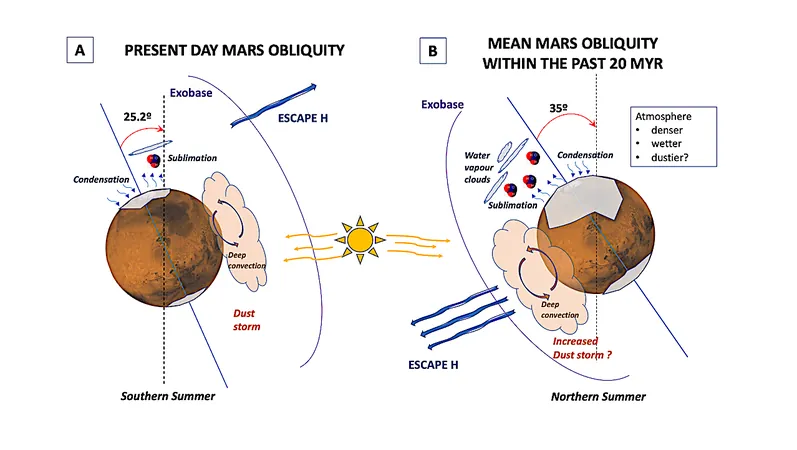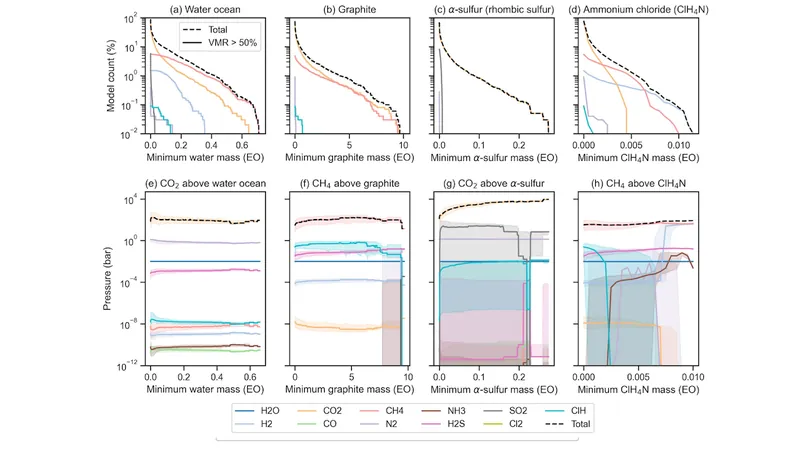
How Mars' Changing Tilt Could Have Drenched and Dried Up the Red Planet
2025-05-23
Author: Sophie
Unlocking the Secrets of Mars' Atmosphere
Recent studies reveal a fascinating evolution of Mars' atmosphere over the past 20 million years, particularly during periods of heightened axial tilt, known as obliquity. This tilt isn’t just a cosmic phenomenon; it plays a crucial role in the planet's climate and the fate of its water.
Mars' Climate Transformation: The Impact of Axial Tilt
Under its current tilt of 25.2 degrees, Mars experiences seasonal changes that allow polar ice caps to sublimate and regenerate. However, during periods of greater axial tilt, the landscape of Mars transformed dramatically, promoting a vigorous water cycle that surpassed today's conditions. It was a time when the northern polar regions basked in intensified sunlight, leading to significant sublimation of surface water.
The Role of Water in Mars' Atmosphere
This increased climate activity provided ample opportunity for water vapor to accumulate in the atmosphere, producing localized ice reservoirs after rainfall in the tropics and mid-latitudes. Thick cloud formations warmed the atmosphere, triggering a feedback loop that enhanced the escape of hydrogen, a critical component leading to Mars' current dry state.
The Mystery of Water Loss on Mars
Despite the ongoing interest, the exact volume of water lost from Mars remains elusive. It's understood that hydrogen escaping into space has been a significant factor in the planet's desiccation. While current loss rates average around 30 sextillion atoms per second, this figure alone cannot account for the vast amounts of liquid water depicted in geological records.
Modeling the Past: Enhanced Hydrogen Escape
Utilizing advanced three-dimensional climate models of Mars, researchers suggest that during periods of greater axial tilt, hydrogen loss rates spiked to more than 60 sextillion atoms per second. This surge in atmospheric escape contributed to an estimated water loss equivalent to approximately 80 meters of global sea level.
Understanding Mars: A Step Closer to Unraveling Its History
As we continue to explore Mars, these revelations about its atmospheric dynamics and water history underscore the complexities of the planet's evolution. How much water once flowed on Mars, and what does it mean for the potential of past life? Each study draws us closer to answering these tantalizing questions about our planetary neighbor, once thought to be a lush oasis.









 Brasil (PT)
Brasil (PT)
 Canada (EN)
Canada (EN)
 Chile (ES)
Chile (ES)
 Česko (CS)
Česko (CS)
 대한민국 (KO)
대한민국 (KO)
 España (ES)
España (ES)
 France (FR)
France (FR)
 Hong Kong (EN)
Hong Kong (EN)
 Italia (IT)
Italia (IT)
 日本 (JA)
日本 (JA)
 Magyarország (HU)
Magyarország (HU)
 Norge (NO)
Norge (NO)
 Polska (PL)
Polska (PL)
 Schweiz (DE)
Schweiz (DE)
 Singapore (EN)
Singapore (EN)
 Sverige (SV)
Sverige (SV)
 Suomi (FI)
Suomi (FI)
 Türkiye (TR)
Türkiye (TR)
 الإمارات العربية المتحدة (AR)
الإمارات العربية المتحدة (AR)